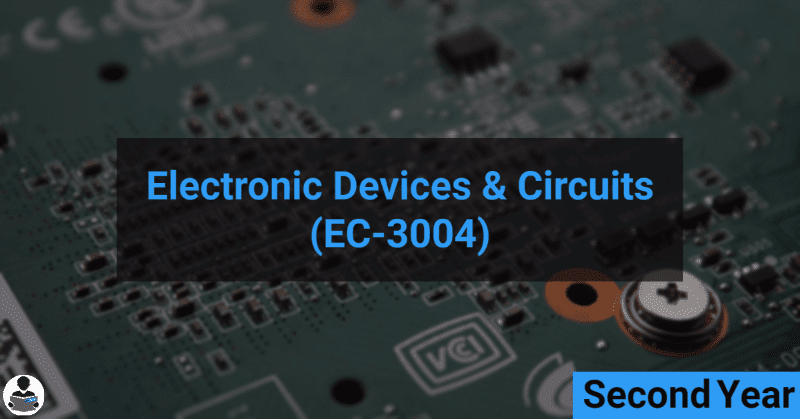Electronic Devices & Circuits (EC-3004)

rgpv bhopal, diploma, rgpv syllabus, rgpv time table, how to get transcript from rgpv, rgpvonline,rgpv question paper, rgpv online question paper, rgpv admit card, rgpv papers, rgpv scheme
RGPV notes CBGS Bachelor of engineering
COURSE OBJECTIVE:
Any electronic trade has its basis on a certain number of components and somebasic standard circuits. These common circuits are applied in all sections of theElectronics technology. A good understanding of the basic functioning of allthese components and circuits will be a solid platform to enter into the morecomplex portion and specialized field of Electronics Engineering.Emphasis has been given on the characteristics and application ofsemiconductor devices/ components. In the case of basic standard circuits, thefocus has been made on the interaction of active and passive components andoverall performance according to the stated requirements.
Syllabus
UNIT 1:
Introduction to semiconductor physics: insulator, conductor, semiconductor and semiconductor types. Drift and
diffusion carries, Hall Effects.
Review of PN junction diode: PN junction diode in forward and reverse bias, temperature dependence of V-I
characteristics, diode resistances, diode junction capacitance. Types of diodes: Zener Diode, Varactor Diode, Tunnel
Diode, PIN Diode, Schottky Diode, LED and Photo Diodes, Switching characteristics of diode.
UNIT 2:
Bipolar junction transistor - Construction, basic operation, current components and equations,CB, CE and CCconfiguration, input and output characteristics, Early effect, Region ofoperations: active, cut-off and saturation
region. BJT as an amplifier. Ebers-Moll model, Power dissipation intransistor (Pd, max rating), Photo transistor.
Transistor biasing circuits and analysis: Introduction, various biasing methods:Fixed bias,Self bias, Voltage
Divider bias, Collector to base bias, Load-line analysis: DC and AC analysis, Operating Point and Bias Stabilization
and Thermal Runaway. Transistor as a switch.
UNIT 3:
Small Signal analysis: Small signal Amplifier,Amplifier Bandwidth, Hybrid model, analysis of transistor amplifier
using h-parameter, Multistage Amplifier: Cascading amplifier, Boot-strapping Technique, Darlington amplifier and
cas-code amplifier, Coupling methods in multistage amplifier,Low and high frequency response, Hybrid πmodel,
Current Mirror circuits.
UNIT 4:
LargeSignal analysis and Power Amplifiers:Class A,Class B,Class AB,Class C,Class D, Transformer coupled and
Push-Pull amplifier.
UNIT 5:
FET construction- JFET: Construction, n-channel and p-channel, transfer and drain characteristics,
parameters,Equivalent model and voltage gain, analysis of FET in CG, CS and CD configuration. Enhancement and
Depletion MOSFET drainand transfer Characteristics.
Uni-junction Transistor (UJT) and Thyristors:UJT: Principle of operation, characteristics, UJT relaxation
oscillator, PNPN Diode and its characteristics, Silicon controlled rectifier: V-I characteristics, DIAC and
TRIAC,Thyristors parameters and applications.
NOTES
- Unit 1
- Unit 2
- Unit 3
- Unit 4
- Unit 5
LIST OF EXPERIMENTS:
1. To determine and analyze the V-I characteristics of PN Junction diode and Zener diode.
2. To determine input and output characteristics of transistor amplifiers in CE, CB &CC configurations.
3. To determine the frequency response of transistor CE amplifier, direct coupled and RC coupled amplifier.
4. To determine characteristics of UJT as relaxation Oscillator.
5. To determine Drain and Transfer Characteristics of JFET Amplifier.
6. To determine Drain and Transfer Characteristics of MOSFET Amplifier.
7. To determine characteristics of class A and B power amplifiers.
8. To determine characteristics of class C and AB power amplifiers.
COURSE OUTCOMES:
Students who are successful in this class will be able to:
1. Understand the basic physics of carrier transport in bulk semiconductors and real device structures.
2. Understand the fundamentals of operation of the main semiconductor electronic devices.
3. Understand the basic parameters of electronic devices, their performance, and limiting factors.
4. Understand the basic principles of electronic device operation with emphasis on bipolar transistors, and
unipolar microwave devices.
TEXTBOOKS
1.Millman and Halkias: Integrated electronics, TMH.
2.Boylestad and Nashelsky: Electronic Devices and Circuit Theory, Pearson Education.
3. http://www.nptelvideos.in/2012/12/basic-electronics-drchitralekha-mahanta.html
REFERENCES:
1.Sedra and Smith: Microelectronics, Oxford Press.
2.Anil K. Maini, VarshaAgarwal: Electronic Devices and Circuits, Wiley Publications.
3.Rashid: Electronic Devices and Circuits, Cengage learning.
4.Donald A Neamen: Electronic Circuits Analysis and Design, TMH
5.Salivahanan: Electronic Circuits Analysis and Design, TMH
6.Mottershead: Electronic Devices and Circuits an introduction, PHI
7.Kumar and Jain: Electronic Devices and Circuits, PHI.
8.David A. Bell Electronic Devices and Circuits Oxford University press.



